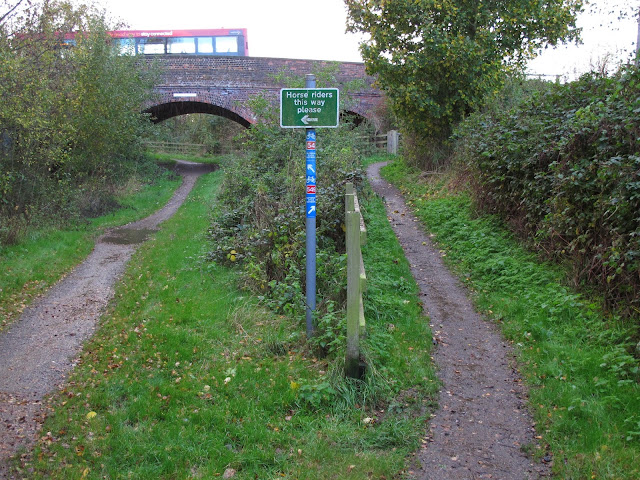It passes mostly through pleasant flat pasture land and although in cuttings at the Mickleover end is mostly on embankments, which is fortunate as the surrounding farm land is prone to flooding and the small stream which it follows, eventually becoming Etwall/Hilton Brook, is not able to cope after heavy rain.
The whole length is part of the National Cycle Network, being both Route 54 and Route 68 until they diverge at Etwall.
Take a seat, we have a good five miles to go and 51 slides to get through.
 |
| Here we go then. Mickleover Station ahead. No car parking past this sign but more than adequate parking closer to Station Road. |
 |
| Through the barrier which prohibits motor cycles and other unauthorised vehicles. |
 |
| For five miles now the path is generally fairly flat and straight with a good surface. There is a slight gradient of 1 in 100 downhill for some distance. |
 |
| There are not many access points along the Greenway, but this one leads up to the houses around the Honeycomb public house. |
 |
| And on the right, up the steps, a footpath leads across the fields to Hackwood Farm where there is a café. The path is not suitable for cycles. |
 |
| In 2012 serious flooding affected houses on the left here, (behind the hedge) and the sandbags are a temporary measure to prevent a recurrence. |
 |
| The fence on the left separates the path from the stream which lies on the other side. |
 |
| On the right, this magnificent oak tree which is over 300 years old, was here before the railway came, and in fact before Queen Victoria acceded to the throne. |
 |
| Opposite, the Sustrans Rangers have built these steps and a seat, where you can rest awhile to watch the activity on the bird feeders. |
The Greenway is marked at accurately measured mile points with large coping stones, all on the left side of the path. There are four of these, the fifth mile point being exactly at (guess what?) Five Mile Gate. |
| Here is Bannel's Gate where the farm can be seen to the left. |
 |
| ...........Bearwardcote Gate (pronounced locally as "Berracut"). |
And next................................
 |
| There are several brick built bridges across the path. They carry only footpaths or farm tracks. This is Badgers Bridge, so called because of the nearby badger setts. |
 |
| Here the deck of Heage Lane Bridge. The white blobs are rain spots on the camera lens. |
To the left are three houses which stand on land which was once the site of a coal gas works. Gas was made from coal delivered by rail and there was a small siding here.
The house in the picture was occupied by the gas works manager.The works were closed about 1904.
 |
| Here Hepnall's Bridge, again named after the nearby farm, which is now, after much building work, described as "Etwall Manor". |
And alongside steps leading to the footpath above, which runs between Etwall and Dalbury villages.
You will hear the sound of traffic here, since the main A516 (the Etwall by-pass) is directly ahead on an embankment behind the trees.
Construction of this road gave rise to the devious nature of the path in this area. If the traffic noise does not bother you, take a breather on yet another seat provided by the Rangers.
Then on towards..............
Route 68 ahead ...........
.
.......... and to the left, passing beneath the A516 by way of this ugly modern concrete monstrosity of a bridge, is our way to Etwall.
 |
| Clear directions from the Sustrans milepost. Burton 7 miles, Derby 7 miles and Ashbourne 14 miles. |
 |
| We will return here to Sutton Lane bridge after a loop through Etwall village, but for now, straight ahead. |
 |
| Phew! A tight fit for the handlebars here. |
It is, so far as we know, the only Pink Bridge in the UK, if not the world.
Just a small reminder of the heritage ........................
.......... and Shadwell, long lamented laborador who loved this place
 |
| Etwall Station stood here. Ahead on the left, is another access point, onto the new housing of Old Station Close. |
 |
| Further on comes Kingfisher Bridge, where you might be lucky enough to espy a kingfisher looking for a meal in the waters of Etwall Brook, which flows beneath the bridge. |
On now to pass beneath the A50 trunk road, which carries heavy traffic between the two Midlands motorways, the M1 and the M6.
Better down here than up there.
Another seat built by the Rangers...........................
 |
| ......... with this fine view opposite. |
 |
| And on to our final bridge, this one being Hargate Bridge, named after the adjacent equestrian centre. |
 |
| From this bridge we come to.......................... |
 |
| ....... and ahead the tall brick chimney marking the site of Egginton Creamery which used to manufacture cream from locally produced milk. The buildings now house a small engineering works. |
 |
| No ride to this point is complete without a visit to a favourite local café, that being Hargate Tea Rooms at Don Amott's Leisure Kingdom, a short ride along the A5132 in the direction of Hilton. |
Future posts will take us on from here, one returning to Mickleover by way of a loop of Etwall village, and the other onto the Hilton Greenway which is NCN Route 549, leading to Uttoxeter. A third will run further along Route 54 to Burton-on-Trent and the cathedral city of Lichfield.
Watch this space.



























